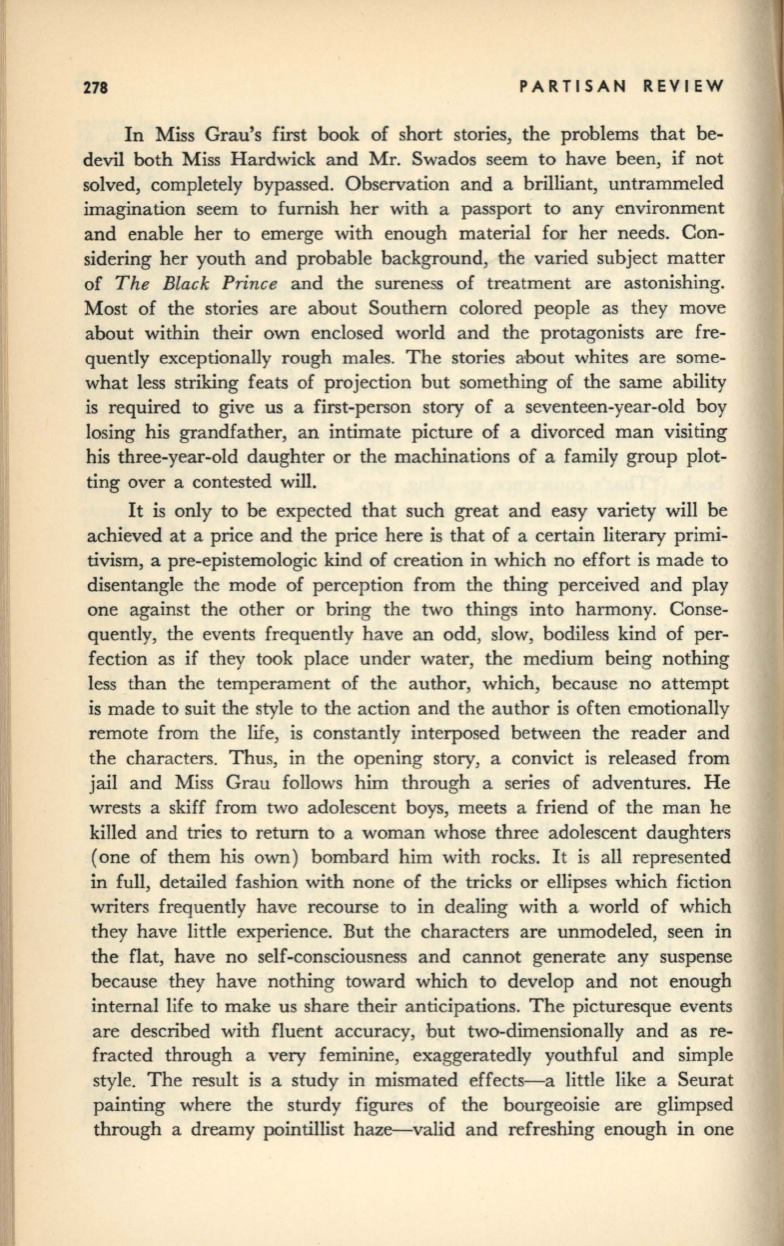
278
PARTISAN REVIEW
In
Miss Grau's first book of short stories, the problems that be–
devil both Miss Hardwick and Mr. Swados seem to have been, if not
solved, completely bypassed. Observation and a brilliant, untrammeled
imagination seem to furnish her with a passport to any environment
and enable her to emerge with enough material for her needs. Con–
sidering her youth and probable background, the varied subject matter
of
The Black Prince
and the sureness of treatment are astonishing.
Most of the stories are about Southern colored people as they move
about within their own enclosed world and the protagonists are fre–
quently exceptionally rough males. The stories about whites are some–
what less striking feats of projection but something of the same ability
is required to give us a first-person story of a seventeen-year-old boy
losing his grandfather, an intimate picture of a divorced man visiting
his three-year-old daughter or the machinations of a family group plot–
ting over a contested will.
It
is only to be expected that such great and easy variety will be
achieved at a price and the price here is that of a certain literary primi–
tivism, a pre-epistemologic kind of creation in which no effort is made to
disentangle the mode of perception from the thing perceived and play
one against the other or bring the two things into harmony. Conse–
quently, the events frequently have an odd, slow, bodiless kind of per–
fection as if they took place under water, the medium being nothing
less than the temperament of the author, which, because no attempt
is made to suit the style to the action and the author is often emotionally
remote from the life, is constantly interposed between the reader and
the characters. Thus, in the opening story, a convict is released from
jail and Miss Grau follows him through a series of adventures. He
wrests a skiff from two adolescent boys, meets a friend of the man he
killed and tries to return to a woman whose three adolescent daughters
(one of them his own) bombard him with rocks. It is all represented
in full, detailed fashion with none of the tricks or ellipses which fiction
writers frequently have recourse to in dealing with a world of which
they have little experience. But the characters are unmode1ed, seen in
the flat, have no self-consciousness and cannot generate any suspense
because they have nothing toward which to develop and not enough
internal life to make us share their anticipations. The picturesque events
are described with fluent accuracy, but two-dimensionally and as re–
fracted through a very feminine, exaggeratedly youthful and simple
style. The result is a study in mismated effects-a little like a Seurat
painting where the sturdy figures of the bourgeoisie are glimpsed
through a dreamy pointillist haze-valid and refreshing enough in one


